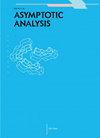磁滞如何在简并反应-扩散系统中产生不连续模式
IF 0.9
4区 数学
Q2 MATHEMATICS, APPLIED
引用次数: 0
摘要
在本文中,我们研究了退化反应-扩散系统解的渐近性质。由于滞后过程的影响,该系统允许连续的不连续平稳解,但只有一个不连续平稳解答符合局部不变区域的保持原理。利用保证快速粒子帮助慢速粒子位移的宏观质量效应,我们建立了一个新的结果,即一组非平凡的轨迹向不连续模式收敛。本文章由计算机程序翻译,如有差异,请以英文原文为准。
How hysteresis produces discontinuous patterns in degenerate reaction–diffusion systems
In this paper, we study the asymptotic behaviour of the solutions to a degenerate reaction–diffusion system. This system admits a continuum of discontinuous stationary solutions due to the effect of a hysteresis process, but only one discontinuous stationary solution is compatible with a principle of preservation of locally invariant regions. Using a macroscopic mass effect which guarantees that fast particles help slow particles to displace, we establish a novel result of convergence of a non trivial set of trajectories towards a discontinuous pattern.
求助全文
通过发布文献求助,成功后即可免费获取论文全文。
去求助
来源期刊

Asymptotic Analysis
数学-应用数学
CiteScore
1.90
自引率
7.10%
发文量
91
审稿时长
6 months
期刊介绍:
The journal Asymptotic Analysis fulfills a twofold function. It aims at publishing original mathematical results in the asymptotic theory of problems affected by the presence of small or large parameters on the one hand, and at giving specific indications of their possible applications to different fields of natural sciences on the other hand. Asymptotic Analysis thus provides mathematicians with a concentrated source of newly acquired information which they may need in the analysis of asymptotic problems.
 求助内容:
求助内容: 应助结果提醒方式:
应助结果提醒方式:


